#Textile Pests
Text
#dirt2neat#carpet cleaning#pest control#Insects#Stored Product Pests#Textile Pests#Spiders#Flying Insects#Rodents
0 notes
Text
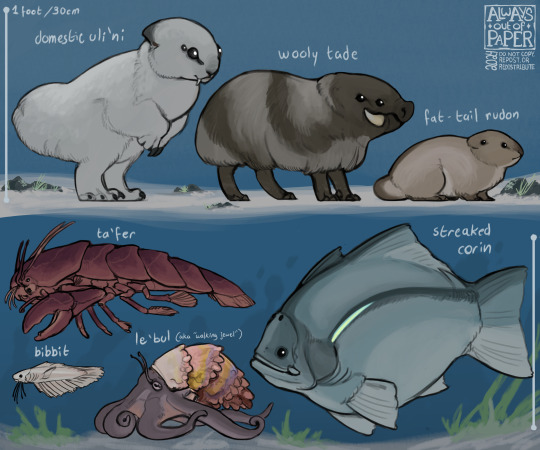
the livestock of haek (top) and haen'oi (bottom), found in and around the landmass/island of Tunib'sau
wanted to draw up some creatures because I haven't created much hae planet fauna. ramblings below the cut, but it's a lot. all you really need to know is all of these animals can be eaten :)
uli'ni are highly social, omnivorous pack hunters (or ambush predators in small numbers), used for pest control by haek. a village can have a near 1:3 ratio of uli'ni to haek, with the pack usually belonging to a single family, or being cared for communally in some cases. bright, soft coats are sought after by haek wanting a pet. there has been a trend of uli'ni being imported into the city as an exotic pet - mainland uli'ni are a lot nastier.
tade are like truffle pigs. they can sniff out root plants from under dirt and snow, so they are critical for farmers when poor weather conditions would normally make harvests miserable. they are usually eaten along with the plants they help harvest. their "wool" is used for bed, bedding, clothes, and other textile things that are otherwise difficult to create with limited fibers. most shed their coats seasonally, but a mainland variety is bred to grow them continuously like sheep.
rudon are the fastest growing, hardest to handle source of protein a haek could ask for. they burrow under the snow, and further into the ground when it isn't covered. raising them is more difficult than hunting them in the wild, but some haek still try, creating stone-lined pits they will fill with dirt to keep rudon contained. they can wreak havoc on any plantlife if left unchecked, so they are rarely raised in the same village as a root plant farm. their fatty tails are used for tallow, which can be sold at high prices or traded for goods if transportation is possible and a surplus is available.
ta'fer is essentially a much meaner lobster. they can pinch, bite, and smack someone around with their tail. they are aggressive to anything that isn't a ta'fer, and evasive when they feel threatened, which makes them difficult to handle without immense caution. the meat is worth it to most haen'oi, though, and just the act of raising them garners a whole lot of respect.
bibbits are some of the most abundant fish (calling them that cus they look like that) in the oceans, found all over the world with different variations. the bibbits found around Tunib'sau are very boney, but those bones are soft and thin, not removed unless necessary (like for baby haek, it could be a choking hazard - baby haen-oi don't have this problem). bibbits are usually smoked and eaten whole for haek, or eaten raw in the water by haen-oi. they are very flavorful, but don't keep well.
le'bul, or the "walking jewel", is a six-limbed nautilus-like critter. they have tentacle-lined arms like octopus, but lack the chromatophores of the same species. they instead rely on their shells for defense and camouflage, evolved to mimic different types of coral, depending on the region they're in. the le'bul shown above grows a shell resembling coral found almost exclusively in underwater caves. tracking them down is a difficult task, but they can be lured out with bibbits, so actually catching them is pretty simple. their shells are often used as decoration or storage depending mostly on the condition of it after the rest of the body is removed.
lastly, corin is basically just a really big tilapia. high in protein, low in fat. their meat is white and not the most flavorful, but it keeps well and their bones are good for making broth. there are much better, tastier fish out there, but these are the easiest for haen'oi to herd, hunt and trade, so it is the most popular option. they're the closest thing to a domestic fish you can get in those waters. some even let you pet them :)
#uli'ni don't look like predators but i dont care. i love them and they would bite my fingers off.#my art#digital art#original species#spec bio#spec evo#worldbuilding#hae world#paper aliens
143 notes
·
View notes
Text
Introduction To Supporting Sustainable Agriculture For Witches and Pagans
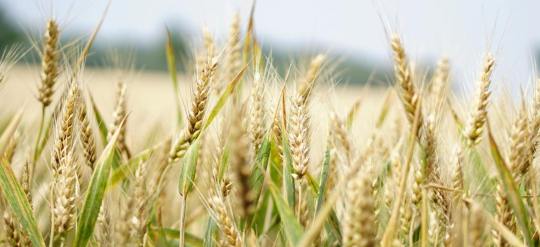
[ID: An image of yellow grain stocks, soon to be harvested. The several stocks reach towards a blurred open sky, focusing the camera on he grains themselves. The leaves of the grains are green and the cereals are exposed].
PAGANISM AND WITCHCRAFT ARE MOVEMENTS WITHIN A SELF-DESTRUCTIVE CAPITALIST SOCIETY. As the world becomes more aware of the importance of sustainability, so does the duty of humanity to uphold the idea of the steward, stemming from various indigenous worldviews, in the modern era. I make this small introduction as a viticulturist working towards organic and environmentally friendly grape production. I also do work on a food farm, as a second job—a regenerative farm, so I suppose that is my qualifications. Sustainable—or rather regenerative agriculture—grows in recognition. And as paganism and witchcraft continue to blossom, learning and supporting sustainability is naturally a path for us to take. I will say that this is influenced by I living in the USA, however, there are thousands of groups across the world for sustainable agriculture, of which tend to be easy to research.
So let us unite in caring for the world together, and here is an introduction to supporting sustainable/regenerative agriculture.
A QUICK BRIEF ON SUSTAINABLE AGRICULTURE
Sustainable agriculture, in truth, is a movement to practise agriculture as it has been done for thousands of years—this time, with more innovation from science and microbiology especially. The legal definition in the USA of sustainable agriculture is:
The term ”sustainable agriculture” (U.S. Code Title 7, Section 3103) means an integrated system of plant and animal production practices having a site-specific application that will over the long-term:
A more common man’s definition would be farming in a way that provides society’s food and textile needs without overuse of natural resources, artificial supplements and pest controls, without compromising the future generation’s needs and ability to produce resources. The agriculture industry has one of the largest and most detrimental impacts on the environment, and sustainable agriculture is the alternative movement to it.
Sustainable agriculture also has the perk of being physically better for you—the nutrient quality of crops in the USA has dropped by 47%, and the majority of our food goes to waste. Imagine if it was composted and reused? Or even better—we buy only what we need. We as pagans and witches can help change this.
BUYING ORGANIC (IT REALLY WORKS)
The first step is buying organic. While cliche, it does work: organic operations have certain rules to abide by, which excludes environmentally dangerous chemicals—many of which, such as DDT, which causes ecological genocide and death to people. Organic operations have to use natural ways of fertilising, such as compost, which to many of us—such as myself—revere the cycle of life, rot, and death. Organic standards do vary depending on the country, but the key idea is farming without artificial fertilisers, using organic seeds, supplementing with animal manure, fertility managed through management practices, etc.
However, organic does have its flaws. Certified organic costs many, of which many small farmers cannot afford. The nutrient quality of organic food, while tending to be better, is still poor compared to regeneratively grown crops. Furthermore, the process to become certified organic is often gruelling—you can practise completely organically, but if you are not certified, it is not organic. Which, while a quality control insurance, is both a bonus and a hurdle.
JOINING A CSA
Moving from organic is joining a CSA (“Community supported agriculture”). The USDA defines far better than I could:
Community Supported Agriculture (CSA), one type of direct marketing, consists of a community of individuals who pledge support to a farm operation so that the farmland becomes, either legally or spiritually, the community’s farm, with the growers and consumers providing mutual support and sharing the risks and benefits of food production.
By purchasing a farm share, you receive food from the farm for the agreed upon production year. I personally enjoy CSAs for the relational aspect—choosing a CSA is about having a relationship, not only with the farmer(s), but also the land you receive food from. I volunteer for my CSA and sometimes I get extra cash from it—partaking in the act of caring for the land. Joining a CSA also means taking your precious capital away from the larger food industry and directly supporting growers—and CSAs typically practise sustainable and/or regenerative agriculture.
CSAs are also found all over the world and many can deliver their products to food deserts and other areas with limited agricultural access. I volunteer from time to time for a food bank that does exactly that with the produce I helped grow on the vegetable farm I work for.
FARM MARKETS AND STALLS
Another way of personally connecting to sustainable agriculture is entering the realm of the farm stall. The farmer’s market is one of my personal favourite experiences—people buzzing about searching for ingredients, smiles as farmers sell crops and products such as honey or baked goods, etc. The personal connection stretches into the earth, and into the past it buries—as I purchase my apples from the stall, I cannot help but see a thousand lives unfold. People have been doing this for thousands of years and here I stand, doing it all over again.
Advertisement
Farmers’ markets are dependent on your local area, yet in most you can still develop personal community connections. Paganism often stresses community as an ideal and a state of life. And witchcraft often stresses a connection to the soil. What better place, then, is purchasing the products from the locals who commune with the land?
VOLUNTEERING
If you are able to, I absolutely recommend volunteering. I have worked with aquaponic systems, food banks, farms, cider-making companies, soil conservation groups, etc. There is so much opportunity—and perhaps employment—in these fields. The knowledge I have gained has been wonderful. As one example, I learned that fertilisers reduce carbon sequestration as plants absorb carbon to help with nutrient intake. If they have all their nutrients ready, they do not need to work to obtain carbon to help absorb it. This does not even get into the symbiotic relationship fungi have with roots, or the world of hyphae. Volunteering provides community and connection. Actions and words change the world, and the world grows ever better with help—including how much or how little you may provide. It also makes a wonderful devotional activity.
RESOURCING FOOD AND COOKING
Buying from farmers is not always easy, however. Produce often has to be processed, requiring labour and work with some crops such as carrots. Other times, it is a hard effort to cook and many of us—such as myself—often have very limited energy. There are solutions to this, thankfully:
Many farmers can and will process foods. Some even do canning, which can be good to stock up on food and lessen the energy inputs.
Value-added products: farms also try to avoid waste, and these products often become dried snacks if fruit, frozen, etc.
Asking farmers if they would be open to accommodating this. Chances are, they would! The farmer I purchase my CSA share from certainly does.
Going to farmers markets instead of buying a CSA, aligning with your energy levels.
And if any of your purchased goods are going unused, you can always freeze them.
DEMETER, CERES, VEIA, ETC: THE FORGOTTEN AGRICULTURE GODS
Agricultural gods are often neglected. Even gods presiding over agriculture often do not have those aspects venerated—Dionysos is a god of viticulture and Apollon a god of cattle. While I myself love Dionysos as a party and wine god, the core of him remains firmly in the vineyards and fields, branching into the expanses of the wild. I find him far more in the curling vines as I prune them than in the simple delights of the wine I ferment. Even more obscure gods, such as Veia, the Etruscan goddess of agriculture, are seldom known.
Persephone receives the worst of this: I enjoy her too as a dread queen, and people do acknowledge her as Kore, but she is far more popular as the queen of the underworld instead of the dear daughter of Demeter. I do understand this, though—I did not feel the might of Demeter and Persephone until I began to move soil with my own hands. A complete difference to the ancient world, where the Eleusinian mysteries appealed to thousands. Times change, and while some things should be left to the past, our link to these gods have been severed. After all, how many of us reading know where our food comes from? I did not until I began to purchase from the land I grew to know personally. The grocery store has become a land of tearing us from the land, instead of the food hub it should be.
Yet, while paganism forgets agriculture gods, they have not forgotten us. The new world of farming is more conductive and welcoming than ever. I find that while older, bigoted people exist, the majority of new farmers tend to be LGBT+. My own boss is trans and aro, and I myself am transgender and gay. The other young farmers I know are some flavour of LGBT+, or mixed/poc. There’s a growing movement for Black farmers, elaborated in a lovely text called We Are Each Other’s Harvest.
Indigenous farming is also growing and I absolutely recommend buying from indigenous farmers. At this point, I consider Demeter to be a patron of LGBT+ people in this regard—she gives an escape to farmers such as myself. Bigotry is far from my mind under her tender care, as divine Helios shines above and Okeanos’ daughters bring fresh water to the crops. Paganism is also more commonly accepted—I find that farmers find out that I am pagan and tell me to do rituals for their crops instead of reacting poorly. Or they’re pagan themselves; a farmer I know turned out to be Wiccan and uses the wheel of the year to keep track of production.
Incorporating these divinities—or concepts surrounding them—into our crafts and altars is the spiritual step towards better agriculture. Holy Demeter continues to guide me, even before I knew it.
WANT CHANGE? DO IT YOURSELF!
If you want change in the world, you have to act. And if you wish for better agriculture, there is always the chance to do it yourself. Sustainable agriculture is often far more accessible than people think: like witchcraft and divination, it is a practice. Homesteading is often appealing to many of us, including myself, and there are plenty of resources to begin. There are even grants to help one improve their home to be more sustainable, i.e. solar panels. Gardening is another, smaller option. Many of us find that plants we grow and nourish are far more potentant in craft, and more receptive to magical workings.
Caring for plants is fundamental to our natures and there are a thousand ways to delve into it. I personally have joined conservation groups, my local soil conservation group, work with the NRCs in the USA, and more. The path to fully reconnecting to nature and agriculture is personal—united in a common cause to fight for this beautiful world. To immerse yourself in sustainable agriculture, I honestly recommend researching and finding your own path. Mine lies in soil and rot, grapevines and fruit trees. Others do vegetables and cereal grains, or perhaps join unions and legislators. Everyone has a share in the beauty of life, our lives stemming from the land’s gentle sprouts.
Questions and or help may be given through my ask box on tumblr—if there is a way I can help, let me know. My knowledge is invaluable I believe, as I continue to learn and grow in the grey-clothed arms of Demeter, Dionysos, and Kore.
FURTHER READING:
Baszile, N. (2021). We are each other’s harvest. HarperCollins.
Hatley, J. (2016). Robin Wall Kimmerer. Braiding Sweetgrass: Indigenous wisdom, scientific knowledge and the teachings of plants. Environmental Philosophy, 13(1), 143–145. https://doi.org/10.5840/envirophil201613137
Regenerative Agriculture 101. (2021, November 29). https://www.nrdc.org/stories/regenerative-agriculture-101#what-is
And in truth, far more than I could count.
References
Community Supported Agriculture | National Agricultural Library. (n.d.). https://www.nal.usda.gov/farms-and-agricultural-production-systems/community-supported-agriculture
Navazio, J. (2012). The Organic seed Grower: A Farmer’s Guide to Vegetable Seed Production. Chelsea Green Publishing.
Plaster, E. (2008). Soil Science and Management. Cengage Learning.
Sheaffer, C. C., & Moncada, K. M. (2012). Introduction to agronomy: food, crops, and environment. Cengage Learning.
Sheldrake, M. (2020). Entangled life: How Fungi Make Our Worlds, Change Our Minds & Shape Our Futures. Random House.
Sustainable Agriculture | National Agricultural Library. (n.d.). https://www.nal.usda.gov/farms-and-agricultural-production-systems/sustainable-agriculture
#dragonis.txt#witchcraft#paganism#hellenic polytheism#witchblr#pagan#helpol#hellenic pagan#hellenic worship#hellenic paganism#hellenic polytheist#demeter deity#demeter worship#persephone deity#kore deity#raspol#etrupol#etruscan polytheist#etruscan polytheism#rasenna polytheism#rasenna polytheist#rasenna paganism
303 notes
·
View notes
Note
What does agriculture and typical plants and animals used in food look like in different regions and cultures?
For the sake of brevity, my answer will only cover this part (but don't worry, I'm working on the plants (and invertebrates) as well) :
VERTEBRATE LIVESTOCK OF UANLIKRI

Thanks to a wide range of environments and intercontinental trade, Uanlikri boasts a wide variety of vertebrate livestock, some domesticated locally, others brought along by settlers from the other continental masses. Most livestock on Uanlikri are ceratopsians (some more highly derived than others).
Caviþ
Pronounced chavith. Caviþ are a highly derived species of ceratopsians originating from the Basin region. The wild species still exist, roaming the southern Basin plains in great hordes.
For the most part, caviþ are kept as beasts of burden and for their meat and leather. In most locales, they are unpopular compared to O'ohu, which are more powerful, meatier, more docile, and have more offspring at once. Nevetheless, keeping caviþ has its avantages: caviþ are smaller, hardy, tolerant of crowding, and produce rough but warm pelts.
In general, caviþ are too small to be ridden by adult antioles, but not for the Apinaat and Abimaat, two peoples of pigmies who make their living on caviþback across the southern Basin plains and on the Matar Peninsula. For the Apinaat and Abimaat, caviþ, wild and domestic, are their whole livelihood. Their use of caviþ as mounts gives them an incomparable edge in warfare and has earned them a fearsome reputation.
Wek
Wek are one of the few non-ceratopsian livestock originating from Uanlikri. They were first domesticated in coastal areas of the Pwetitwì range from large gull-like birds, and spread from there to most northern coastal areas of Uanlikri. Wek are meaty and adaptable birds kept for their eggs, plumage, and guano. They require access to open water to thrive, but accept saltwater and freshwater alike. They are primarily kept in coastal areas, as well as along the Koramme river and Basin Great Lakes, where the slow-moving waters suit them fine.
Kabi
Kabi, a guinea pig sized ceratopsian, are the most widely kept livestock on Uanlikri. The kabi in the picture was enlarged for ease of viewing: the vast majority of kabi breeds are much smaller, though giant breeds do exist. Kabi are a multi-purpose livestock: they are bred for their meat, abundant eggs, soft patterned pelts, and companionship. Kabi are extremely adaptable and very tolerant of crowding. Their ease of keeping in urban environments has made them ubiquitous through all the cities of the continent.
There are hundreds of kabi breeds and landraces on the continent. Kabi have a tendency to establish themselves as feral pests as well as livestock, where natural selection by the environment encourages the development of landraces best adapted to the local climate. They also make excellent pets due to their highly social nature, and many lines of kabi are bred purely for good temperament and pleasing (though sometimes extreme) appearance. Kabi are also ubiquitous overseas: it is unclear where they were first domesticated, but most theories point towards dwarf and standard kabi originating from one domestication event on Uanlikri, and red-leg kabi originating from another domestication event overseas, possibly of a different but related species: this would explain some of the difficulties in breeding dwarf and standard kabi to red-leg kabi.
Tsut
Tsut were one of the livestock species brought along by the Senq Ha Empire, conquerors and settlers of the Western Peninsula. These diminutive therizinosaurids were selected through millenia for an extremely downy, frizzy coat which can be sheared and spun like wool. Of all Senq Ha livestock, tsut were the ones to find the fastest and most widespread adoption, only limited by their destructive browsing habits and preference for hilly terrains and cool weathers. Tsut down revolutionized the world of textiles in Uanlikri, where spun-down fibres were previously very rare and very expensive, requiring capture and shearing of wild animals with very little suitable fibre.
Tsut are primarily raised for their fiber but also provide meat and more importantly crop-milk. Consumption of crop-milk is slow to catch in communities not descended from the Senq Ha, but the Senq Ha's people use crop milk abundantly, using it fresh or processed in dozens of different ways.
Llekme
Llekme were domesticated in the Northern peninsulas of Uanlikri from a species related to the caviþ. They share many of the caviþ issues and advantages, being hardy but temperamental. However, contrarily to the caviþ, they are an extremely popular livestock among both sedentary and nomadic populations Uanlikri's north. There, they are used as beasts of burdens and pulling animals of limited power as well as for their meat. For the desert nomads of the Atashir, llekme provide essential help in carrying their tents and tools; in cities, they are often used as pulling animals, working alone or in teams to pull small carts and coaches.
Hêtâ
Hêtâ are family of highly derived ceratopsians, including a dozen species and subspecies on the mainland and a few endemic island species. They are, in truth, not yet a domestic species. All species of hêtâ are game animals highly appreciated for their ornemental feathers and delicious meat, and there have been several attempts to domesticate various species of mainland hêtâ, none of which have been successful. Mainland hêtâ have extremely nervous dispositions, are prone to dying from stress, and mostly fail to reproduce in captivity: they rarely breed, and when they do, they most often do not provide parental care, leading to the death of the chicks.
This said, there is an ongoing project on the Ojame archipelago to restore and domesticate the near-extinct Ojame hêtâ. The Ojame hêtâ is endemic to the archipelago. Due to the absence of large predators on the archipelago, it has evolved to be larger and much less fearful than mainland hêtâ, but was driven to near extinction by hunting and the introduction of larger, bolder breeds of oujabe [dog analogue] from the mainland and of continental hêtâ imported for use as wild game.
The failure of mainland domestication attempts and a joint desire to preserve and profit from the Ojame hêtâ has led to a unique, unusually coordinated project to domesticate and reestablish the Ojame hêtâ. In a rare show of goodwill and collaboration, this project is shared by both Wetki and Ranaite communities on the archipelago. The Ojame hêtâ is thought to be a promising source of meat and ornemental feathers as its population levels rise and stabilized. Successful captive reproduction has been achieved, and semi-domesticated captive population are being reintroduced to Êrar, the archipelago's largest island where the hêtâ had been completely eradicated.
Wagwacguk
The wagwacguk (wag-wash-guk) is a wild animal living as familial herds in the tundras south of the Kantishian, with a domestic subspecies of marginal range in the lands of the Daghwa-Igdø and the Kantishian High Plateau. It is a large, extremely hardy animal with a warm, plush coat and thick leather. For the Daghwa-Igdø, wagwacguk are their main livelihood. One month per year, they feast on the fresh meat of wagwacguk calves, culling their herds as the first dayfrosts touch their lands; the later kills are preserved by smoking and freezing. The rest of the year, wagwacguk blood provides them with most of the protein in their diet. Wagwacguk pelts, leather, guts, horn and hooves are the materials involved in most of their material culture.
Though domestic wagwacguk are most closely associated with the Daghwa-Igdø, they are also kept by the Oubixwø-øi of the Kantishian high plateau as part of the Oubixwø-oi's diverse survival strategies.
O'ohu
O'ohu are domestic hadrosaurs named, in most regions where they are kept, after their loud and haunting cry. They are the largest and second-most widespread livestock on Uanlikri. Where they are kept, they are invaluable for their work as beasts of burden: plowing fields, pulling carts, carrying charges of all kinds. They are essential to the work of peasants and armies alike, and they are surprisingly fast. Historically, they have often been used in active combat, pulling war chariots. They cannot be ridden: their back ridge is too fragile to bear the weight of a rider and their alternatively bipedal and quadrupedal gait makes balancing a saddle impossible. They are also used for meat, blood, leather, and other byproducts. Their finely scaled and patterned leather is considered especially attractive, and their hollow horns are often made into music instruments. In many cultures, O'ohu grastroliths are considered to have medicinal properties as the ultimate digestive aid, and are often sold at a considerable markup by gastrolith merchants.
#worldbuilding#uanlikri#speculative biology#speculative evolution#dinosaur#antiole world#art by me#asks#feel free to send the agriculture and plants asks again btw i'm working on it I just felt this would get wayyy too long#caviþ#chavith#kabi#llekme#wek#hêtâ#heta#tsut#wagwacguk#o'ohu#long post
64 notes
·
View notes
Text
Mammon is a Caterpillar
and NOT just in the Wonderland merch. Though the merch casting him as the caterpillar is what made me finally make the connection! See, there's several aspects about Mammon's design that just do not match with the popular assumption that he's a spider.
For one thing...

he has too many limbs. After his transformation he has ten visible limbs. Plus the legs that he has in his normal form, that's a total of twelve limbs. And we have precedent for how Spindlehorse would handle a spider inspired character...
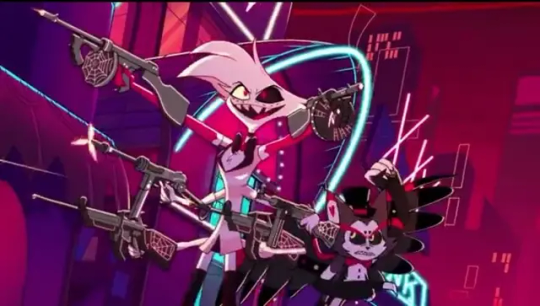
so it seems unlikely that this design principle was simply thrown out the window with Mammon.
What's particularly interesting to me is that caterpillars only have six "true" legs, like other insects. The rest of their legs are what are called prolegs, or a "small, fleshy, stub structure found on the ventral surface of the abdomen" (per wikipedia). These prolegs often look distinctly different from the caterpillars true legs, which is similar to how the eight legs in Mammon's full demonic form are unlike the rest of his limbs.
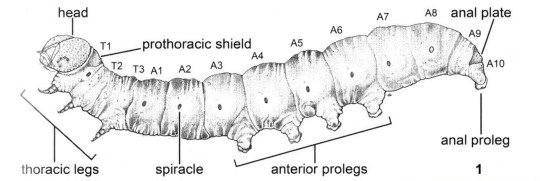
But if that's not enough evidence, consider:
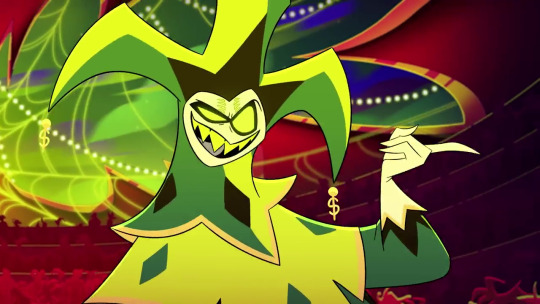
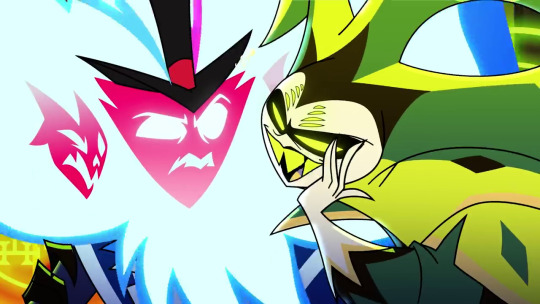
He has too many eyes. The number of eyes a spider has can vary, but they never have more than eight. The number of eyes visible on Mammon depends on the shot, but the most he's ever depicted with, shown above, is ten. While it's more common for caterpillars to have twelve eyes, there are some species with ten! And once again, if we refer back to Angel Dust, we can see that he has eight.
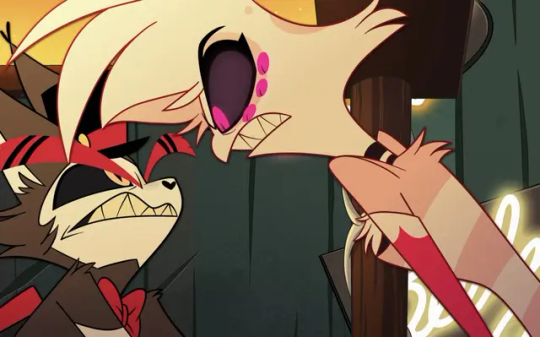
While it could be argued that Mammon is intended to be a sort of "spidertaur" it would be, in my opinion, egregious to get the number of limbs AND the number of eyes wrong in his design.
So what's the deal with the webbing seen around the arena, specifically where Mammon sits during Fizz's performance? I have a theory about that!
1.) This element of his design is in reference to silk worms. Bombyx mori are a species of moth most known for being a primary producer of silk, a fiber used in textiles and well known for being luxurious and expensive. The silk worm's cocoon doesn't look very similar to a spider's web, of course, which brings me to my second point...
2.) Mammon is a performer who wants to associate himself with a predator known for luring its prey into a web over something most known for getting boiled to death for a byproduct of its pupation (yes, that's really how silk is obtained). It's his entire shtick, and I think he's performing at being a spider as much as he is at being a clown. Mimicry is a well known defense mechanism of caterpillars, after all. Lastly...
3.) Spiders are simply more marketable than caterpillars. After all, Spider-man has a long history in comic books and a zillion film reboots, but you've probably never even heard of a Caterpillar-man, have you? :P
There's a lot of caterpillars out there that I think Spindlehorse could have drawn inspiration for Mammon's design from. A quick google search for "green caterpillar" will return a diverse amount of results, but here's some of my favorites:
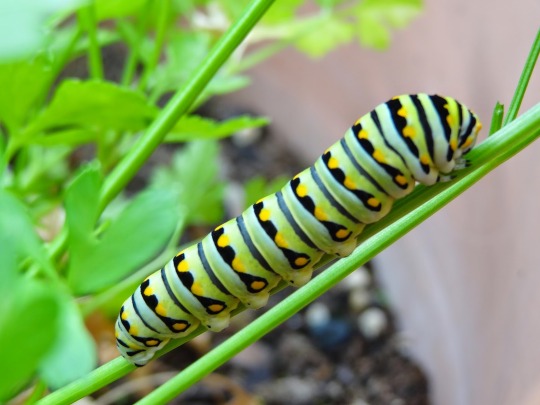
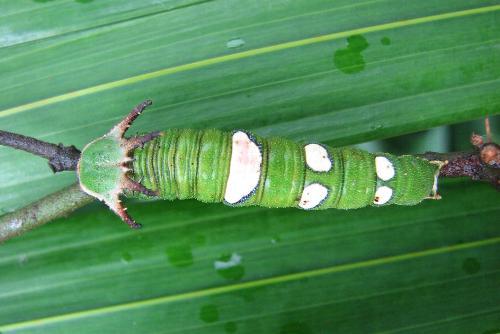


Eastern Black Swallowtail, Orange Emperor, Lace Emerald, Imperial Moth.
For fun I also looked into literary symbolism for caterpillars, to see if there was any precedent for an association with greed, and here's what I found:
The caterpillar appears in the Old Testament as a pest that devours crops; it is included with "pestilence, blasting, mildew, locust" ... and associated with the locust as one of the plagues of Egypt.
Shakespeare's Bolingbroke has it in for King Richard's friends, "Bushy, Bagot, and their complices, / The caterpillars of the commonwealth, / Which I have sworn to weed and pluck away" ... Jack Cade and his rebels are more radical: All scholars, lawyers, courtiers, gentlemen, / They call false caterpillars and intend their death"
excerpts from "A Dictionary of Literary Symbols" by Michael Ferber.
Thanks for coming to my TED Talk. c:
#helluva boss#helluva boss mammon#mammon helluva boss#insects cw#helluva boss meta#mammon's magnificent musical#i made this#callioposte
49 notes
·
View notes
Note
Going off the inkcap into ink ask, apart from food and ink, what else can I do/make with fungus?
here's a little list !! :-)
with artist's conk brackets, you can use the underside for drawing as - when the flesh is scraped away - there is a brown layer underneath. when it dries & hardens the art will keep for a long time :-)
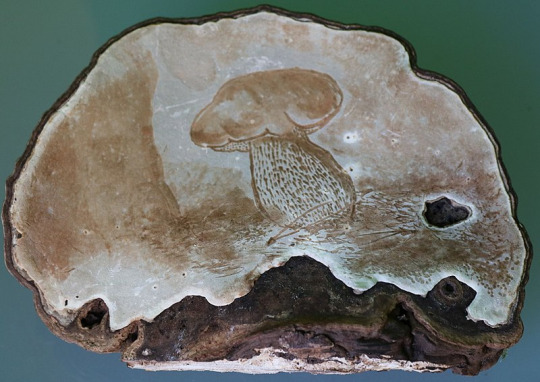
mushrooms that contain psilocybin are used as psychedelic drugs - the most potent is p. azurescens.

many different fungi can be used as dyes -
many moulds are used in food manufacturing processes, for example when making cheese or yoghurt.
you can purchase mycopesticides to control pests.
yeast is a fungus that we consume every day through beer, wine, soy sauce & bread products. :-)
that's about all i've got for you, luna !! <3
#• askbox replies: •#(ask : luminousmoon21)#[ganoderma applanatum]#: artist's palette :#: artist's fungus :#: artist's conk :#: artist's bracket :#: bear bread :#||#fungi#mould#mold#fungus#mycology#[psilocybe azurescens]
56 notes
·
View notes
Text
avatrice AU concept proposal
lmk if this is anything lol i was struck with an idea for an avatrice museum curator/time travel AU based on my job working as a curator for a historic home
Concept Summary:
2024 -- Ava, a classical archaeologist with a unique supernatural gift, is offered a position as a museum curator at a historic country estate in England for the summer touring season. She is hesitant to accept as it's not really her field, but her research money has dried up, and she takes the job.
1874 -- Beatrice, the daughter of a wealthy baron, reckons with a gnawing suspicion that there is more to her family's livelihood than meets the eye. She becomes distracted from her investigation by strange happenings in her home.
Scene: Camilla, the daycamp director for the museum, is helping Ava to clean her office and go through old records.
Dialogue sneak peek (based on a conversation with my coworker):
//
Ava squints at the budget ledger.
“I’m not usually in charge of this stuff.” She flips a page. “I don’t think Jillian would want to leave me in charge of the finances if she saw how I was funding my research.”
Camila laughs, leaning over the desk to help Ava find the right numbers.
“Here.” She points at a column. “This was our account for last season, and the camps got by. You can propose the same amount this year and I’ll survive.” She shrugs.
Ava sighs and closes the ledger. “Thanks.” She knits her brows together and studies Camilla’s face for a second.
“You know, I’m really glad you’re here, I don’t know if I’d survive the season if it was just Lilith.”
Camilla laughs again, brighter. “Lilith is just...” She ponders. “You know those conservator types. They don’t want just anyone touching their artifacts.”
Ava smirks. “I don’t know, maybe if she let someone get all up in her artifacts she could loosen up a little.”
“Ava!”
“I’m getting the distinct feeling someone wouldn’t mind sorting through her filing cabinet—”
Camilla turns red and covers her ears. “Stop it! Right now—”
“What was it that you said? ‘Sure Lilith, I can help you move the textiles to acid-free boxes, actually, I’m kind of a box expert myself—'”
“I will leave you down here to peel the dead mice off the floor on your own.” Camilla threatens, stepping toward the door.
“Alright, I’m done, I’m done. Please don’t go.” Ava begs for her to come back into the office. They both look around at the mess.
“I can’t believe the pests have wrecked this place so much since our last tours.” Camilla says.
Ava swipes a finger through dust on a shelf. She wrinkles her nose at the mouse droppings on the windowsill and bends over to look at the dried mouse carcass underneath the couch.
“You’re telling me. I might have to burn most of this paper.” Ava stands to gesture at a stack of disorganized records. She pulls a latex glove over her hand. “Can’t keep it if it's contaminated.”
“Yuck. Well, I’d rather deal with the mice and the kids than the ghosts any day.” Camilla casually picks up a dustpan and crouches to poke at the mouse.
Ava freezes. “...the what?”
Camilla looks up at her. “Haven’t you heard all of the stories?”
Ava throws up her hands. “No! Jillian told me this place wasn’t haunted.”
“Oh.” Camilla clears her throat. “Just kidding then.”
“What!”
//
lmk if you would read more i guess bc i have such a great idea cooking up idk if it's lame or not
11 notes
·
View notes
Text
most giants only herd two or three mammoths because mammoths are growing scarcer in skyrim's age of agriculture. the relationship between a giant and their mammoths is mutually beneficial; the mammoths provide milk and "wool" for textiles and the giants offer the mammoths protection from ambitious hunters and farmers fending off pests from their crops
70 notes
·
View notes
Note
Opinions in hemp cloth/fabric? I saw one of your post talking about polyster vs cotton/wool/linen
Hi! Thank you for the question! When I was writing that post/addition, I actually forgot the existence of hemp (not that it's among the most important natural fabrics today (sadly)). And when I went to check some sources to make sure I didn't get things wrong, I learned that cotton also gets stronger when wet, which I had previously learned the other way around. (I had gotten it wrong in that post too.)
Hemp is an amazing material. It's very similar to linen in it's properties, in some regards even better. Like linen it's extremely breathable, so great for hot weather, and antibacterial, so it doesn't smell easily and when against skin, keeps it cleaner too. It has even better water absorption abilities than linen, which is why it doesn't feel wet even when it has absorbed a good amount of sweat or water in general. Like linen (and apparently cotton) it gets stronger when wet too, which makes washing and sanitizing it without damaging it easy. It's also even before getting wet super strong, the strongest plant fiber there is. It even has one ability linen doesn't have (nor most plant fibers) it's UV resistant, adding to it's great abilities for summer use.
One thing I didn't mention in that post about linen, which makes it still very relevant, is that growing linen is so much more ecological than growing cotton, which requires a ton of fresh water. Flax (the plant linen is made of) grows very easily in fairly harsh conditions and doesn't need fertilizers, which are often damaging to the ecosystem. However, hemp does the same and better. It's very resistant to pests, so doesn't need extra pestilence that could have adverse effects to the ecosystem, and unlike most other monocultural farmland, it even enriches the earth, keeping the earth resistant against erosion.
All of these properties are why it was used for sails and ropes for millennia. Its very long and strong fibers allow it to be made into very thick canvas excellent for sails. Hemp canvas was also used for stiff interlining. But it got me thinking, why isn't hemp often talked about in clothing history (except in the fact that it was the first plant fiber to be woven into fabric)? It has such obviously excellent properties, which surely would have been attractive to pre-industrial people with limited resources. After looking around I found couple of explanations.
Hemp was indeed used widely for clothes, especially in rural setting. Since it became the first plant fabric in central Asia, it was the primary fabric for clothing in China till the introduction of cotton around a millennium ago. It was used in Europe too since the Goths introduced it in antiquity. However in historical texts (at least in 16th-18th century) hemp cloth is also often referred to as linen and it can be hard to distinguish if the fabric written about was actually made from hemp or flax, since they did make fairly similar cloth. There was a limiting factor too for more widespread use of hemp, since it's processing into fabric was labour intensive, which got better in Industrial Era, when some of the most labor intensive parts were able to be mechanized. It was though very easy and cheap to grow, and needed especially little attention in summer, when farmers had most work. Because of it's enriching properties it also could be grown in the same plot year after year. For these reasons it was often grown in small quantities within small-scale farming even when large scale farming was becoming more common. It's perhaps where the rural association came from, as it was likely grown for personal household textiles and not for selling.
Though there was of course larger scale farming of it and records of selling it by merchants after feudalism started fading, even if the labour intensive processing made it less profitable. Apparently one of the most popular usages for hemp in clothing was men's shirts, for upper and lower classes. Sailors also often wore hemp clothing as it was so excellent and durable in all the conditions that would come across at sea. Hemp also was not as fine as linen, and while very fine hemp was soft and as linen softens in use and with every wash, it still wasn't quite as soft and fine as linen could be. So especially upper classes, who wouldn't need the maximum practicality and durability, would opt into linen, which was still very practical and durable, but also a bit more comfortable against skin.
At the time, when labour was plentiful and relatively cheap compared to land, hemp was still profitable. Entering the Industrial Era this started to change as industrial production requiring less human labour was much cheaper and therefore left more profit margin, so the capitalists now controlling production would greatly favor materials that could be produced industrially. While the processing of hemp became less labour intensive with mechanization, it was still much more labour intensive than cotton for example, which was the first thing that was industrialized. Hemp production was still fairly wide through 19th century and to early 20th century, even if declining in it's share of the clothing production like all the rest of the natural fabrics (except cotton).
But then the war on drugs happened. Now the hemp typically used for clothing is not exactly the same used for weed (there's different strains and then male and female and it seems complicated and I don't know that much about plants), what I read it doesn't have at least very strong psychoactive qualities unlike those used specifically for weed (though there was some overlap). Of course that didn't stop growing hemp being banned very widely, leading the hemp fabric production to plummet in the latter half of 1900s. Growing hemp has become easier now, but the prohibition still create hurdles for farmers. Which sucks a lot because it's such an amazing material and with modern mechanized processing it's cheap to make (and can be made to be really soft) on top of being excellent quality and gentle to environment.
So I guess my opinion is hemp is great we should make more of it instead of cotton and especially synthetic fibers and legalize weed.
#answers#history#textiles#textile history#fashion history#fashion#clothing history#dress history#fabrics#hemp
146 notes
·
View notes
Text
Sustainable Yarns for Eco-Friendly Fashion
Discover sustainable yarns for eco-friendly fashion, including organic, recycled, and renewable options. Learn how to make environmentally responsible choices.

Introduction:
In recent years, the fashion industry has seen a significant shift towards sustainability. As consumers become more conscious of environmental issues, the demand for eco-friendly fashion has grown. One crucial aspect of sustainable fashion is the use of sustainable yarns. These yarns are produced with minimal environmental impact and are often made from renewable or recycled materials. In this guide, we will explore the various types of sustainable yarns and their benefits, helping you make informed choices for eco-friendly fashion.
1. Organic Cotton Yarns:
Organic cotton is one of the most popular sustainable yarns in the fashion industry. Grown without the use of synthetic pesticides or fertilizers, organic cotton farming promotes soil health and biodiversity. Organic cotton yarns are soft, breathable, and biodegradable, making them ideal for a wide range of clothing items, from everyday wear to luxury garments. Additionally, organic cotton is often certified by organizations such as GOTS (Global Organic Textile Standard), ensuring high environmental and social standards.
2. Recycled Yarns:
Recycled yarns are made from post-consumer or post-industrial waste, such as discarded textiles, plastic bottles, and other materials. By repurposing waste materials, recycled yarns reduce the need for virgin resources and help minimize landfill waste. Common recycled yarns include recycled polyester, recycled nylon, and recycled cotton. These yarns offer comparable quality and durability to their non-recycled counterparts while significantly reducing environmental impact.
3. Hemp Yarns:
Hemp is a highly sustainable and versatile plant that has been used in textile production for centuries. Hemp yarns are strong, durable, and naturally resistant to pests, which means they require minimal chemical inputs during cultivation. Hemp also grows quickly and uses less water compared to cotton, making it an eco-friendly choice for sustainable fashion. Hemp yarns can be used for a variety of garments, including casual wear, activewear, and accessories.
4. Bamboo Yarns:
Bamboo is another sustainable material gaining popularity in the fashion industry. Bamboo plants grow rapidly without the need for pesticides or fertilizers, making them an environmentally friendly option. Bamboo yarns are soft, lightweight, and have natural moisture-wicking and antibacterial properties. However, it's important to choose bamboo yarns that are produced using environmentally responsible processes, as some methods of bamboo fiber extraction can be chemically intensive.
5. Tencel (Lyocell) Yarns:
Tencel, also known as Lyocell, is a type of yarn made from sustainably sourced wood pulp, typically from eucalyptus, beech, or spruce trees. The production process for Tencel is closed-loop, meaning that almost all solvents and water used in the process are recycled and reused. Tencel yarns are known for their softness, breathability, and biodegradability. They are an excellent choice for eco-friendly fashion, suitable for everything from casual wear to high-end garments.
6. Wool and Alpaca Yarns:
Natural animal fibers such as wool and alpaca are inherently sustainable when sourced responsibly. These fibers are renewable, biodegradable, and have excellent thermal properties. Sustainable wool and alpaca yarns come from farms that prioritize animal welfare, land stewardship, and ethical practices. Certifications such as the Responsible Wool Standard (RWS) ensure that the wool is produced in an environmentally and socially responsible manner.
7. Linen Yarns:
Linen, made from the flax plant, is one of the oldest and most sustainable fibers used in textiles. Flax requires minimal water and pesticides to grow and can thrive in poor soil conditions. Linen yarns are strong, durable, and breathable, making them perfect for warm-weather clothing. Linen production has a relatively low environmental impact, and the resulting fabric is fully biodegradable.
8. Sustainable Dyeing and Finishing:
In addition to choosing sustainable yarns, it's important to consider the dyeing and finishing processes. Eco-friendly dyeing methods, such as using natural dyes or low-impact synthetic dyes, reduce the release of harmful chemicals into the environment. Furthermore, water-saving techniques and energy-efficient practices in the finishing process contribute to the overall sustainability of the final product.
Conclusion:
Sustainable yarns are a cornerstone of eco-friendly fashion, offering a range of options for creating garments that are both stylish and environmentally responsible. By choosing yarns made from organic, recycled, or renewable materials, and ensuring responsible production processes, designers and manufacturers can significantly reduce their environmental footprint. As the demand for sustainable fashion continues to grow, embracing sustainable yarns will play a crucial role in shaping a greener, more ethical fashion industry.
2 notes
·
View notes
Text
The Man from Black Water, Chapter 4
A/N As promised, here in a pre-Christmas installment of my crossover fic. In it, we see Jamie find a place for himself at Netherton, despite hostilities on all sides. He and Claire are finally formally introduced, and we learn a bit more about Claire’s plans for her future.
Previous chapters and a character mapping to the Man from Snowy River universe can be found on my AO3 page.
Merry Christmas to all who celebrate, and a safe and happy holiday to all!

From his imposing stature to his iceberg gaze, Dougal Mackenzie would have been the epitome of a Highland warrior, had he been born two hundred years earlier. As it was, he’d grown up in the industrial slums on the south banks of the Clyde, going to work in the textile mills at the age of twelve. Being on the winning side of a knife fight several years later saw him fleeing the city in search of less hostile horizons. Brawn made him a desirable labourer. An ability to keep difficult men in line with his ominous reputation made him an adept foreman. He’d risen through the ranks to become the chief overseer of Netherton’s agricultural holdings over the past twenty years.
“He’s a hard worker, that one,” the estate’s chief cook remarked to Dougal as they crossed paths in the kailyard one afternoon. She gestured towards Jamie, who toiled nearby, splitting firewood for the kitchen stoves with admirable economy. The August sun stared down from an azure sky, and he occasionally paused to wipe sweat from his eyes and take a swig of water from a tin canteen sitting in the shade of an ornamental rosebush. Rollo lay nearby, his pink tongue afurl in the hot air.
“Aye, seems willing enough,” Dougal said a bit begrudgingly. He hadn’t been consulted about the hiring of this latest labourer, which rankled him. There was a long list of cronies he would sooner have assisted.
“I canna understand why the master hired him,” the stout woman continued in a lower tone. “He comes from the Highlands.” This last word was pronounced as though it was a communicable disease. Despite being in the shadow of the Grampian mountains, Netherton had always been staffed by Lowland Scots, even if, like Dougal himself, they were only a couple generations removed from their Gaelic roots.
Dougal had entertained similar thoughts himself, but he wasn’t about to stand about and gossip with the house staff about them.
“Twas a long time ago,” he said instead. “Good day, Mrs. Crook.”
Walking past the woodpile, he called out.
“Fraser, when ye’re done here, ye can muck out the stables.”
“Yes, sir.”
Despite a dark blue smear of sweat across the back of his cambric shirt, the young man seemed cheerfully willing to work without pause. He wasn’t even breathing hard. Dougal stalked back to his quarters in a foul mood.
***
Netherton’s stables were more luxurious than any croft Jamie had ever set foot in, with two long rows of stalls bisected by a stone alleyway that funneled the mountain breeze in summer and absorbed the anemic sunlight in winter. Still, horse shite was horse shite, no matter how pampered the beast that produced it.
Most of the animals were away from their stalls, either grazing in the paddock near the river where the grass was the sweetest or serving as mounts to Netherton’s large workforce. This made Jamie’s job easier, but he missed the opportunity to gaze into their limpid brown eyes and admire their glossy coats. He was on his sixth stall when two familiar pests stopped to watch him.
“Lookit than, Rupe. The teuchter’s shovellin’ shite. Pretty canny fer a teuchter, usin’ the flat end o’ the shovel an’ everything.”
This was Angus, a dark wiry stockhand who was perpetually spoiling for a fight. His companion, Rupert, was a soft-bellied lout who followed Angus around like a sheepdog, laughing obligingly at his jokes. Jamie had met men like them before and did his best to ignore them.
“They eat a lot of neeps an’ tatties in the Highlands, Rupe. Are ye diggin’ fer yer supper, laddie boy?”
Jamie unbent to his full height, well over a head taller than Angus. The smaller man stepped back but made a show of lighting a cigarette with casual indifference.
“Have they given ye the day off, Angus?” Jamie asked.
“I’m studyin’ tae be supervisor,” Angus declared with no little arrogance.
Staring Jamie directly in the eye, he let the still-burning match drop into the dry straw at his feet. A tiny curl of smoke immediately rose. Jamie casually hefted a shovelful of moist excrement onto the growing flame. It was an advertent error that saw some of the load land on Angus’ well-polished leather boots. The bully’s fists went up. Rollo let out a low growl of warning. Jamie tossed his shovel to the side in preparation for the altercation.
“What have you been up to, Kip?”
Claire Beauchamp’s precise elocution acted like a bucket of cold water and all three men scrambled to appear innocuous. Angus was quick to offer his assistance saddling her usual mount. When she refused, he and Rupert left the stables on the pretense of having work to accomplish elsewhere, which was doubtful.
For his part, Jamie went back to mucking stalls while still surreptitiously observing his employer’s daughter. She was carrying on a one-sided conversation with her horse as he was wont to do himself when he was alone. Her luxurious curls were tied back behind her ears but cascaded over her shoulders. She was at least wearing a riding frock today, although she appeared to be preparing to ride without supervision.
“Can I help ye?” he asked, when he noticed she was struggling with the gray mare’s halter.
“No, I’m fine,” she replied without so much as glancing his way.
Out of the corner of his eye, Jamie watched her stubbornly endeavour to repair the halter for another few minutes. Rather than offer his assistance again, he merely fashioned a halter and lead from a nearby coil of rope using a knot his father had taught him as a lad.
“Oh,” the young lady remarked as he slipped the harness over the docile mare’s ears. “How did you do that?”
Eager to show off his competency at something other than mucking stalls or chopping firewood, Jamie demonstrated the technique behind the Tom Fool’s knot, enjoying the way the lass’ golden eyes narrowed in concentration as she followed each movement of his hands. No matter how hard she tried, she couldn’t duplicate his efforts, and they both ended up chuckling at her ineptitude.
“You’re the boy from the train station,” she realized after they had finished tacking up her horse together. Jamie wasn’t certain whether to be pleased she remembered him or not. Certainly, the use of the word ‘boy’ wasn’t flattering.
“Aye,” he acknowledged. “James Fraser, mistress,” he introduced himself while politely removing his cap.
“I’m afraid I wasn’t very courteous that day,” she half-apologized with a subtle grimace. “A constitutional failing, I’m told.”
Sticking out her gloved hand, she introduced herself, as though he wasn’t aware to whom he’d been speaking all along. “Claire Elizabeth Beauchamp.”
He’d never shook a woman’s hand before and was uncertain as to the appropriate response. He wasn’t some titled suitor who might kiss her knuckles, even if they weren’t encased in leather. A firm shake such as he’d been taught seemed equally unsuitable. He was saved from having to hold her dainty grip indefinitely by her father riding into the stables. They both dropped the other’s hand as though the contact suddenly burned.
“Fraser, cool off this horse and stable him,” the cattle baron commanded.
“Aye, sir.”
Jamie was walking away when he heard the man release an exasperated sigh.
***
“Why aren’t you at your lessons?”
It was always a tender balance, deciding how much leeway to give his headstrong daughter, and when to rein her in. Lately, his attempts to argue that more feminine propriety was required if she was to secure a husband were met with greater and greater resistance.
“One of the broodmares is about to foal,” Claire replied. “I want to be there to help her.”
“The men are quite capable of handling it,” he argued, drawing his unwilling daughter back towards the manor house with a firm arm around her shoulder.
“I can do it better. If I’m to be a veterinarian, I shall need as much firsthand experience as I can obtain.”
This fixation with attending the Royal Veterinary College in Edinburgh was one matter in which he’d indulged his daughter for too long. He’d been certain she’d outgrow the notion as she emerged into womanhood.
“You should be concerning yourself with marriage, child rearing,” he explained for the hundredth time.
“The gentleman cattle breeder has a breeding program for his daughter as well,” Claire retorted, demonstrating the independent spirit and sharp wit that made him despair of ever finding her a husband.
“You’ll spend the afternoon at the manor with your Aunt Rosemary,” he decreed, feeling his face grow hot in frustration. “And Mister Randall will come to call on you this Saturday. I don’t,” he forestalled her protest with a raised hand, “want to hear another word about it. You are my daughter, and you will obey me.”
Watching her skirts swish angrily across the courtyard as she hastened away, Henry Beauchamp wondered how his only child could so resemble a mother she’d never met.
32 notes
·
View notes
Text
humans develop weaving -> humans develop agriculture and a wider variety of textiles from the new cultivated plants and animals -> humans need pest control around their agricultural settlements -> cats domesticate by becoming even cuter and developing an endless killer instinct for local pests -> idiot cat is defeated by a simple pillow their claw is stuck in
7 notes
·
View notes
Text
Hemp: A Sustainable Solution for a Greener Planet
World Environment Day 5th June
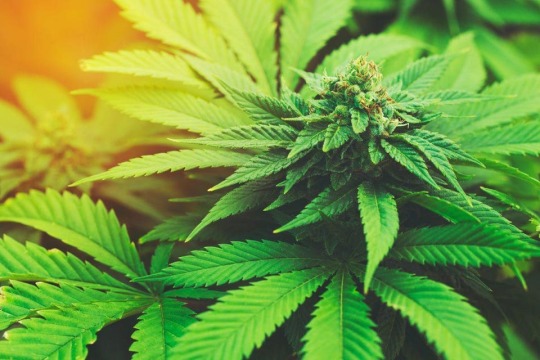
Climate change and environmental degradation have become pressing global concerns, prompting the search for sustainable alternatives to traditional materials and practices. One such alternative is hemp, a versatile plant with numerous applications in various industries. This article explores the environmental benefits of hemp cultivation and its potential to contribute to a cleaner, healthier, and more sustainable planet.
Hemp's Environmental Benefits
1. Carbon Sequestration
Hemp plants are highly effective at absorbing carbon dioxide (CO2) from the atmosphere, helping to combat climate change. Studies have shown that a single acre of hemp cultivation can absorb as much as 4.1 metric tons of CO2 per year. This remarkable ability to sequester carbon makes hemp an essential ally in the fight against global warming.
2. Water Conservation
Hemp requires significantly less water than other crops, such as cotton, using about 50% less water during cultivation. This makes hemp an ideal choice for sustainable agriculture, particularly in regions facing water scarcity.
3. Natural Pest Resistance
Hemp is naturally resistant to pests and diseases, reducing the need for harmful pesticides. By replacing pesticide-dependent crops like cotton with hemp, we can significantly decrease the environmental impact of agricultural activities and reduce greenhouse gas emissions.
4. Renewable Energy Source
Hemp seeds can be used to produce biodiesel, a sustainable alternative to fossil fuels. Hemp-based biofuels have the potential to reduce our reliance on non-renewable energy sources and decrease our carbon footprint. Moreover, hemp can be grown in poor soil conditions and requires little land, making it an efficient and eco-friendly option for biofuel production.

5. Sustainable Building Materials
Hemp can be used to create environmentally friendly building materials, such as hempcrete, which is a mixture of hemp fibres and lime. Hempcrete has excellent insulation properties, is mould-resistant, and has a lower carbon footprint than traditional building materials like concrete and steel. By incorporating hemp-based materials into construction, we can reduce emissions and toxic chemicals released into the environment.
6. Eco-friendly Textiles
Hemp fibres can be used to produce sustainable textiles that are biodegradable and require fewer resources during production. Hemp fabric is a more environmentally friendly alternative to cotton, as it has lower carbon emissions and captures more CO2 from the atmosphere.
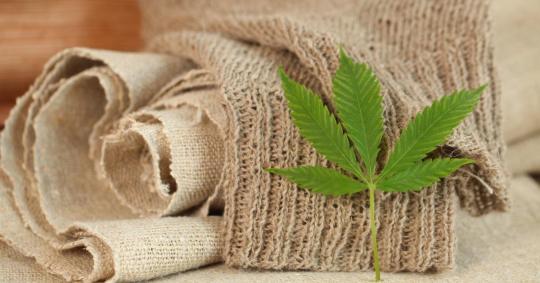
7. Paper Production
Hemp can also be used to produce paper, offering a sustainable alternative to wood-based paper products. Hemp paper requires less water and chemicals during production and is more recyclable than wood paper. By replacing wood with hemp in paper manufacturing, we can slow down deforestation and reduce the environmental impact of the paper industry.
8. Biodegradable Plastics
Hemp-based plastics are biodegradable and have a shorter degradation time compared to conventional plastics. By replacing petroleum-based plastics with hemp alternatives, we can reduce plastic pollution and its harmful effects on the environment.
Conclusion
Hemp offers a multitude of environmental benefits, making it a promising solution for a greener and more sustainable future. Its ability to sequester carbon, conserve water, resist pests, and provide renewable energy sources, along with its applications in eco-friendly building materials, textiles, paper production, and biodegradable plastics, demonstrates its potential to revolutionise various industries and contribute to a cleaner planet.
As the world continues to grapple with climate change and environmental degradation, embracing sustainable practices and materials like hemp is crucial. With proper cultivation, harvesting, and extraction methods, hemp and its related compounds have the potential to significantly impact our efforts to combat climate change and promote a more sustainable future for generations to come.
2 notes
·
View notes
Text
Non Woven Fabric Material | Favourite Fab
Non-woven fabric is an innovative material made from fibers that are bonded together through various processes, such as heat, chemicals, or mechanical means. Unlike traditional woven fabrics, non-woven materials do not require weaving or knitting, making them a versatile choice for a variety of applications. At Favourite Fab, we specialize in providing high-quality non-woven fabric materials for diverse industries.

1. What is Non-Woven Fabric?
Non-woven fabric is produced by layering and bonding fibers, resulting in a fabric that is strong, durable, and flexible. It can be made from various materials, including polypropylene (PP), polyester (PET), and viscose. Depending on the manufacturing process, non-woven fabrics can be engineered to meet specific requirements for strength, absorbency, and breathability.
2. Key Features
Durability: Non-woven fabrics are known for their strength and resistance to tearing, making them suitable for heavy-duty applications.
Breathability: Many non-woven materials are designed to allow air and moisture to pass through, providing comfort in products like medical wear.
Cost-Effectiveness: The production process is generally more economical than traditional fabrics, making non-woven materials a budget-friendly option.
3. Applications
Non-woven fabrics have a wide range of applications, including:
Medical: Used in surgical gowns, masks, and drapes for hygiene and protection.
Packaging: Ideal for shopping bags, food packaging, and product wraps due to their lightweight and strong properties.
Agriculture: Utilized in crop covers and protective fabrics to promote plant growth and protection from pests.
Home Textiles: Commonly found in items like carpets, wipes, and filters.
4. Why Choose Favourite Fab?
At Favourite Fab, we offer a diverse range of non-woven fabric materials tailored to meet your specific needs. Our fabrics are produced to high standards, ensuring quality and reliability for all applications.
Conclusion
Non-woven fabric is a versatile and durable material suitable for various industries. Whether you need it for medical, agricultural, or packaging purposes, Favourite Fab has the right solutions for you.
0 notes
Text
PP Fibrillated Yarn: Enhancing Durability in End Products
In the world of textiles and materials, durability is a key factor that manufacturers and consumers alike consider when choosing products. One innovative material that has gained popularity for its strength and versatility is PP Fibrillated Yarn Price. This specialized yarn is increasingly used across various industries, enhancing the durability of end products and offering numerous benefits. In this blog, we will explore what PP fibrillated yarn is, its properties, applications, and how it contributes to creating long-lasting products.
What is PP Fibrillated Yarn?
PP fibrillated yarn is made from polypropylene, a thermoplastic polymer known for its excellent strength-to-weight ratio. The term "fibrillated" refers to the process by which the yarn is extruded and then split into PP Fibrillated Yarn Suppliers filaments, creating a network of interconnected strands. This unique structure not only provides enhanced strength but also increases the surface area of the yarn, allowing for improved adhesion in various applications.
Key Properties of PP Fibrillated Yarn
Strength: One of the standout features of PP fibrillated yarn is its remarkable tensile strength. This makes it suitable for applications where durability is essential.
Lightweight: Despite its strength, PP fibrillated yarn is lightweight, which helps reduce the overall weight of products without compromising their integrity.
Chemical Resistance: Polypropylene exhibits resistance to many chemicals, making PP fibrillated yarn suitable for use in challenging environments.
Moisture Resistance: The yarn does not absorb water, which helps prevent mold and mildew, further enhancing its durability.
UV Stability: PP fibrillated yarn can be treated to resist degradation from ultraviolet (UV) light, extending the lifespan of products exposed to sunlight.
Applications of PP Fibrillated Yarn
PP fibrillated yarn is used across various sectors due to its unique properties. Here are some common applications where this material shines:
1. Geotextiles
In civil engineering and construction, PP fibrillated yarn is widely used in geotextiles for applications such as soil stabilization, erosion control, and drainage systems. Its strength and moisture resistance make it ideal for reinforcing soil structures and preventing erosion, thus enhancing the durability of infrastructure projects.
2. Agriculture
In agricultural applications, PP fibrillated yarn is utilized for making nets and ropes. These products are used for securing crops, shading plants, and creating barriers against pests. The durability of the yarn ensures that these agricultural tools withstand harsh weather conditions, leading to better crop yields and reduced costs associated with replacements.
3. Non-Woven Fabrics
PP fibrillated yarn is a popular choice in the production of non-woven fabrics. These fabrics are widely used in hygiene products, such as diapers and sanitary pads, as well as in medical applications like surgical masks. The durability and moisture resistance of PP fibrillated yarn enhance the longevity and effectiveness of these products, providing consumers with reliable options.
4. Industrial Applications
In various industrial settings, PP fibrillated yarn is used for making durable packaging materials, tarpaulins, and conveyor belts. Its strength and lightweight properties make it an ideal choice for applications where performance and longevity are critical. Manufacturers benefit from reduced replacement costs due to the enhanced durability of products made with this yarn.
5. Sports and Leisure
PP fibrillated yarn is also used in sports nets, ropes, and other recreational equipment. The durability and resistance to environmental factors ensure that sports gear can withstand rigorous use over time. Whether it's fishing nets or sports field fencing, products made from PP fibrillated yarn provide reliable performance.
Enhancing Durability in End Products
The unique structure and properties of PP fibrillated yarn contribute significantly to enhancing the durability of end products. Here’s how:
1. Improved Adhesion
The fibrillated structure increases the surface area of the yarn, allowing for better adhesion when used in composite materials. This is particularly important in applications where multiple layers or materials are bonded together. Stronger adhesion means greater durability and a longer lifespan for the final product.
2. Resistance to Environmental Factors
PP fibrillated yarn’s resistance to moisture, chemicals, and UV light helps protect products from environmental degradation. For instance, outdoor furniture made with PP fibrillated yarn will last longer, retaining its appearance and structural integrity despite exposure to sun and rain.
3. Lightweight and Strong
The combination of being lightweight and strong allows manufacturers to create products that are easy to handle and transport without compromising durability. This is particularly beneficial in industries like shipping and logistics, where weight can significantly affect costs.
4. Cost-Effectiveness
Investing in products made with PP fibrillated yarn can be cost-effective in the long run. Although the initial investment may be higher than traditional materials, the reduced need for replacements and maintenance, combined with the enhanced performance, leads to savings over time.
Choosing the Right PP Fibrillated Yarn
When selecting PP fibrillated yarn for specific applications, it’s essential to consider factors such as tensile strength, thickness, and UV resistance. Different projects may require different specifications, and working with reputable suppliers who can provide quality assurance is crucial.
Tips for Selection:
Understand the Application: Identify the specific requirements of the end product and choose a yarn that meets those needs.
Consult with Experts: Engage with manufacturers or suppliers who can guide you in selecting the right type of PP fibrillated yarn based on your project.
Test Samples: Whenever possible, request samples to test the performance of the yarn in real-world conditions before making a bulk purchase.
Conclusion
PP fibrillated yarn has emerged as a game-changer in various industries, providing enhanced durability and versatility in end products. Its unique properties, including strength, lightweight nature, and resistance to Fibrillated Polypropylene Yarn factors, make it an ideal choice for applications ranging from construction and agriculture to textiles and sports gear.
As businesses continue to seek durable solutions that can withstand the rigors of daily use, PP fibrillated yarn stands out as a reliable option. By investing in this innovative material, manufacturers can enhance the longevity of their products, ultimately leading to cost savings and improved customer satisfaction. Whether you are in construction, agriculture, or any industry that values durability, considering PP fibrillated yarn may be one of the best decisions for your product development strategy.
Frequently Asked Questions (FAQs):
1. What is PP fibrillated yarn, and how does Singhal Industries utilize it in their products?
PP fibrillated yarn is a type of yarn made from polypropylene that features a unique fibrillated structure, enhancing its strength and durability. Singhal Industries uses this innovative material in various applications, including geotextiles, agricultural nets, and non-woven fabrics, ensuring high-quality and long-lasting products.
2. How does Singhal Industries ensure the durability of their products made from PP fibrillated yarn?
Singhal Industries ensures durability by selecting high-quality PP fibrillated yarn that offers excellent tensile strength, moisture resistance, and UV stability. This attention to material quality, combined with advanced manufacturing processes, allows them to create products that withstand environmental challenges and provide reliable performance over time.
3. Why should businesses choose Singhal Industries for their PP fibrillated yarn needs?
Businesses should choose Singhal Industries for their PP fibrillated yarn needs due to the company’s commitment to quality and innovation. With a focus on enhancing product durability and performance, Singhal Industries provides a wide range of solutions tailored to meet specific industry requirements, ensuring customer satisfaction and cost-effectiveness.
0 notes
Text
Biotechnology Market Outlook: Trends, Challenges, and Opportunities
The global biotechnology market, valued at USD 2100 billion in 2023, is projected to expand at a robust compound annual growth rate (CAGR) of 13.29%, reaching an impressive USD 6430 billion by 2032. With innovations in healthcare, pharmaceuticals, agriculture, and bio-industrial applications fueling this growth, the biotechnology industry is set to experience unprecedented expansion over the next decade.
Biotechnology, a key player in modern science and technology, has revolutionized multiple industries through innovations in genetic engineering, biomanufacturing, and medical therapies. As the world faces increasing demands for sustainable solutions to health, food security, and environmental challenges, biotechnology will remain at the forefront of driving these global changes.
Key Market Drivers
Advancements in Medical Biotechnology
Breakthroughs in gene editing technologies such as CRISPR, the rise of personalized medicine, and the growth of biopharmaceuticals have positioned medical biotechnology as a critical growth driver. Therapies derived from biological organisms, such as monoclonal antibodies and vaccines, are seeing increased demand, particularly as the world navigates new and emerging diseases.
Expansion of Agricultural Biotechnology
With the growing global population and the subsequent demand for sustainable food production, agricultural biotechnology plays a vital role. Genetically modified crops, pest-resistant plants, and precision farming technologies are helping to enhance food production, improve yields, and reduce the use of chemical pesticides and fertilizers. This sector's growth is essential for addressing food security challenges.
Environmental Biotechnology and Sustainability
Biotechnology is increasingly being applied to address environmental challenges, including waste management, pollution control, and the development of biofuels. Innovations in bioprocessing and synthetic biology are leading to the creation of biodegradable materials and renewable energy sources, positioning the industry as a leader in sustainable solutions.
Rising Demand for Bio-based Industrial Products
Industrial biotechnology, often referred to as "white biotechnology," is growing rapidly due to its application in producing bio-based chemicals, enzymes, and biofuels. These eco-friendly alternatives are becoming essential in reducing dependence on fossil fuels and lowering carbon footprints across industries such as manufacturing, textiles, and transportation.
Government Support and Regulatory Approvals
Governments worldwide are supporting the biotechnology industry through favorable policies, research funding, and regulatory approvals for new biotechnological products. Initiatives aimed at boosting innovation, especially in healthcare and environmental sustainability, are expected to accelerate market growth in the coming years.
Get Free Sample Report: https://www.snsinsider.com/sample-request/4523
Market Segmentation
The biotechnology market is segmented based on application, technology, and region.
By Application:
Healthcare and Pharmaceuticals
The healthcare sector dominates the biotechnology market, with biopharmaceuticals, vaccines, gene therapies, and regenerative medicine leading the way. Personalized medicine and the development of targeted therapies based on patients’ genetic profiles are driving the demand for biotechnological innovations.
Agriculture and Food
Agricultural biotechnology is seeing increasing adoption due to the need for improved crop yields, pest resistance, and the production of genetically modified organisms (GMOs). The industry is also focusing on producing sustainable and healthier food options.
Industrial Processing
Biotechnology’s role in industrial processing includes the production of biofuels, biodegradable plastics, and industrial enzymes. This segment’s growth is closely tied to sustainability efforts and the demand for environmentally friendly alternatives to petrochemicals.
Environmental Biotechnology
This sector focuses on bioremediation, waste treatment, and pollution control, utilizing microorganisms and biological processes to solve environmental challenges. The creation of bio-based materials also falls within this category, further emphasizing sustainability.
By Technology:
Genetic Engineering
Genetic engineering, which involves the direct manipulation of an organism’s genome, is a cornerstone of modern biotechnology. The development of CRISPR-Cas9 technology has revolutionized genetic engineering by enabling precise gene editing, driving advancements in both healthcare and agriculture.
Fermentation
Fermentation technology is used extensively in bioprocessing to produce bio-based products such as pharmaceuticals, biofuels, and industrial chemicals. The adoption of fermentation technology is increasing due to its efficiency in large-scale production.
Tissue Engineering and Regenerative Medicine
Tissue engineering is growing rapidly, with applications in developing artificial organs, regenerating damaged tissues, and creating biologically compatible materials. This field is crucial for advancing regenerative medicine and personalized healthcare.
Bioinformatics
Bioinformatics involves the use of computational tools to analyze biological data, particularly genetic sequences. As genomics and proteomics data grow exponentially, bioinformatics is becoming essential for drug discovery, disease research, and personalized medicine development.
By Region:
North America
North America leads the biotechnology market, thanks to strong investments in research and development, advanced healthcare infrastructure, and a well-established biopharmaceutical sector. The U.S., in particular, continues to dominate the market, with major biotech hubs such as Boston and San Francisco driving innovation.
Europe
Europe is the second-largest market for biotechnology, with significant growth driven by advancements in healthcare, environmental biotechnology, and bio-based industrial products. The region’s strong regulatory framework and support for sustainable initiatives are key factors in market expansion.
Asia-Pacific
The Asia-Pacific region is expected to witness the highest growth during the forecast period, driven by rapid urbanization, population growth, and increasing investments in healthcare infrastructure. Countries such as China, India, and Japan are becoming key players in agricultural biotechnology and biopharmaceuticals.
Key Market Players
Several key players dominate the global biotechnology market, including:
Amgen Inc.
A pioneer in biopharmaceuticals, Amgen focuses on discovering, developing, and manufacturing innovative therapeutics based on advances in cellular and molecular biology.
Gilead Sciences, Inc.
Known for its leadership in antiviral drugs, Gilead Sciences is a major player in biotechnology, focusing on transforming the treatment of serious diseases.
Biogen
Biogen specializes in neurological treatments, particularly in multiple sclerosis, Alzheimer’s disease, and neurodegenerative disorders.
F. Hoffmann-La Roche Ltd.
Roche is a global leader in pharmaceuticals and diagnostics, with a focus on personalized healthcare through biotechnological innovations.
Novozymes
As a leader in industrial biotechnology, Novozymes produces enzymes and microbes for industries such as agriculture, bioenergy, and waste management, driving sustainability through biotechnology.
Future Outlook
The biotechnology market’s rapid expansion is fueled by technological advancements, growing healthcare needs, and increasing global efforts toward sustainability. Innovations in genetic engineering, biopharmaceuticals, and agricultural biotechnology will continue to drive growth in the coming years. As industries across the globe integrate biotechnological solutions to address pressing challenges, the market is expected to experience sustained growth, potentially reshaping healthcare, food production, and environmental sustainability.
0 notes